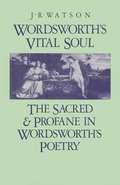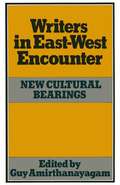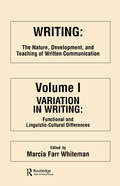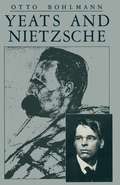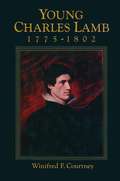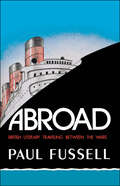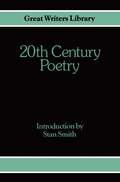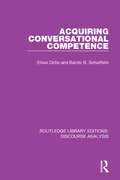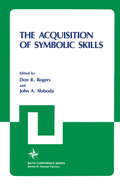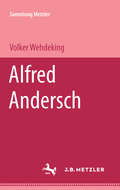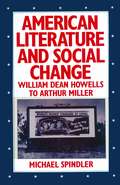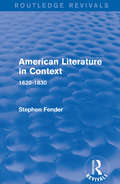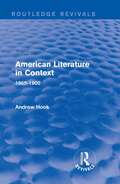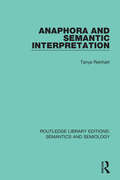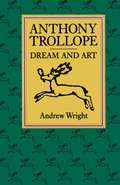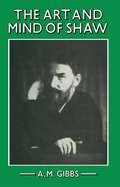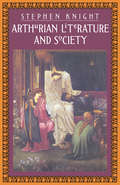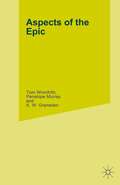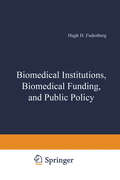- Table View
- List View
Writing: The Nature, Development, and Teaching of Written Communication
by M. Farr WhitemanFirst Published in 1982. Routledge is an imprint of Taylor & Francis, an informa company.
Writing: The Nature, Development, and Teaching of Written Communication
by M. Farr WhitemanFirst Published in 1982. Routledge is an imprint of Taylor & Francis, an informa company.
Yeats and Nietzsche: An Exploration of Major Nietzschean Echoes in the Writings of William Butler Yeats
by Otto BohlmannYeats Annual: An Annual Of Critical And Textual Studies 1995 (Macmillan Literary Annuals #13)
by Richard J. FinneranAbroad: British Literary Traveling between the Wars
by Paul FussellA book about the meaning of travel, about how important the topic has been for writers for two and a half centuries, and about how excellent the literature of travel happened to be in England and America in the 1920s and 30s.
Acquiring conversational competence (RLE: Discourse Analysis)
by Elinor Ochs Bambi B. SchieffelinFirst published in 1983, this book represents a substantial body of detailed research on children’s language and communication, and more generally on the nature of interactive spoken discourse. It looks at areas of competence often examined in young children’s speech have that have not been described for adults — leading to insights not only in the character of adult conversation but also the process of acquiring this competence. The authors set forward strategies for conversing at different stage of life, while also relating these strategies to, and formulating hypotheses concerning, the dynamics of language variation and change.
Acquiring conversational competence (RLE: Discourse Analysis)
by Elinor Ochs Bambi B. SchieffelinFirst published in 1983, this book represents a substantial body of detailed research on children’s language and communication, and more generally on the nature of interactive spoken discourse. It looks at areas of competence often examined in young children’s speech have that have not been described for adults — leading to insights not only in the character of adult conversation but also the process of acquiring this competence. The authors set forward strategies for conversing at different stage of life, while also relating these strategies to, and formulating hypotheses concerning, the dynamics of language variation and change.
The Acquisition of Symbolic Skills (Nato Conference Series #22)
by Don Rogers John A. SlobodaThis book is a selection of papers from a conference which took place at the University of Keele in July 1982. The conference was an extraordinarily enjoyable one, and we would like to take this opportunity of thanking all participants for helping to make it so. The conference was intended to allow scholars working on different aspects of symbolic behaviour to compare findings, to look for common ground, and to identify differences between the various areas. We hope that it was successful in these aims: the assiduous reader may judge for himself. Several themes emerged during the course of the conference. Some of these were: 1. There is a distinction to be made between those symbol systems which attempt, more or less directly, to represent a state of affairs in the world (e. g. language, drawing, map and navigational skill) and those in which the representational function is complemented, if not overshadowed, by properties of the symbol system itself, and the systematic inter-relations that symbols can have to one another (e. g. music, mathematics). The distinction is not absolute, for the nature of all symbolic skills is, in part, a function of the structure of the symbolic system employed. Nonetheless, this distinction helps us to understand some common acquisition difficulties, such as that experienced in mathematics, where mental manipulation of symbols can go awry if a child assumes too close a correspondence between mathematical symbols and the world they represent. 2.
American Literature and Social Change (pdf): William Dean Howells to Arthur Miller
by Michael SpindlerAmerican Literature in Context: 1620-1830 (Routledge Revivals: American Literature in Context)
by Stephen FenderFirst published between 1982 and 1983, this series examines the peculiarly American cultural context out of which the nation’s literature has developed. Covering the years from 1620 to 1830, this first volume of American Literature in Context examines a range of texts from the writings of the Puritan settlers through the declaration of Independence to the novels of Fenimore Cooper. In doing so, it shows how early Americans thought about their growing nation, their arguments for immigration, for political and cultural independence, and the doubts they experienced in this ambitious project. This book will be of interest to those studying American literature and American studies.
American Literature in Context: 1865-1900 (Routledge Revivals: American Literature in Context)
by Andrew HookFirst published between 1982 and 1983, this series examines the peculiarly American cultural context out of which the nation’s literature has developed. Covering the years from 1865 to 1900, this third volume of American Literature in Context focuses on the struggles of American writers to make sense of their rapidly changing world. In addition to such major figures as Walt Whitman, Henry James, Emily Dickinson and Mark Twain, it analyses the writings of an unorthodox economist (Henry George), a Utopian reformer (Edward Bellamy) and a critical sociologist (Thorstein Veblen). Particular attention is paid to the challenge to conventional literary and cultural values represented by writers such as William Dean Howell who pursued a new form of scientific, democratic realism in American writing. This book will be of interest to those studying American literature and American studies.
American Literature in Context: 1865-1900 (Routledge Revivals: American Literature in Context)
by Andrew HookFirst published between 1982 and 1983, this series examines the peculiarly American cultural context out of which the nation’s literature has developed. Covering the years from 1865 to 1900, this third volume of American Literature in Context focuses on the struggles of American writers to make sense of their rapidly changing world. In addition to such major figures as Walt Whitman, Henry James, Emily Dickinson and Mark Twain, it analyses the writings of an unorthodox economist (Henry George), a Utopian reformer (Edward Bellamy) and a critical sociologist (Thorstein Veblen). Particular attention is paid to the challenge to conventional literary and cultural values represented by writers such as William Dean Howell who pursued a new form of scientific, democratic realism in American writing. This book will be of interest to those studying American literature and American studies.
American Literature in Context: 1620-1830 (Routledge Revivals: American Literature in Context)
by Stephen FenderFirst published between 1982 and 1983, this series examines the peculiarly American cultural context out of which the nation’s literature has developed. Covering the years from 1620 to 1830, this first volume of American Literature in Context examines a range of texts from the writings of the Puritan settlers through the declaration of Independence to the novels of Fenimore Cooper. In doing so, it shows how early Americans thought about their growing nation, their arguments for immigration, for political and cultural independence, and the doubts they experienced in this ambitious project. This book will be of interest to those studying American literature and American studies.
Anaphora and Semantic Interpretation (Routledge Library Editions: Semantics and Semiology)
by Tanya ReinhartFirst published in 1983, this book examines anaphora — a central issue in linguistic theory as it lies at the crossroads of several major problems. On the one hand it is believed that the same conditions that govern the interpretation of anaphora also govern syntactic movement rules but on the other, while anaphora is known to interact with various discourse and semantic considerations, it also provides a clear instance of the dependency of the semantic interpretation of sentences upon semantic properties of natural language. This book has two major goals: the first is a comprehensive analysis of sentence-level anaphora that addresses the questions posed above, and the second is an examination of the broader issues of the relations between the structural properties of sentences and their semantic interpretation within the hypotheses of the autonomy of syntax and of interpretative semantics shown by Chomsky.
Anaphora and Semantic Interpretation (Routledge Library Editions: Semantics and Semiology)
by Tanya ReinhartFirst published in 1983, this book examines anaphora — a central issue in linguistic theory as it lies at the crossroads of several major problems. On the one hand it is believed that the same conditions that govern the interpretation of anaphora also govern syntactic movement rules but on the other, while anaphora is known to interact with various discourse and semantic considerations, it also provides a clear instance of the dependency of the semantic interpretation of sentences upon semantic properties of natural language. This book has two major goals: the first is a comprehensive analysis of sentence-level anaphora that addresses the questions posed above, and the second is an examination of the broader issues of the relations between the structural properties of sentences and their semantic interpretation within the hypotheses of the autonomy of syntax and of interpretative semantics shown by Chomsky.
Biomedical Institutions, Biomedical Funding, and Public Policy
by H. HughFudenbergThe world is on the threshold of a great new industrial revolution, a 1 scientific-industrial revolution. Recombinant DNA technology and hybridoma technology ("monoclonal antibodies") have already pro vided unique investment opportunities for venture capitalists. Hence published reports of biomedical research are no longer restricted to scientific journals, but now appear regularly not only in weekly news 2 magazines like Time and U. S. News & World Report,3 but also in the financial sections of The New York Times,4 The Wall Street Journal,S 6 8 Business Week, Fortune,7 and The Economist, as well as in such stock 9 market advisory publications as New Issues and Inc. (The Magazine for Growing Companies). 10 These publications now appear to be as impor tant to biomedical scientists in keeping abreast of new scientific devel opments in biotechnology as is Current Contents. (The costs of health cost provision and of fundamental biomedical research are now also being followed by such media. ) Conversely, Wall Street financial bro kers increasingly no longer confine their reading to economic journals but are also perusing Nature,ll Science,12 and Science N 13 for infor ews mation on both fiscal and scientific advances in these areas. It is obvious that the information explosion in biotechnology is crossing traditional boundaries (e. g. , ref. 14). This volume is the second of several that are intended to inform both the biomedical community and interested intelligent laymen of the political and economic implications of biomedical research.
